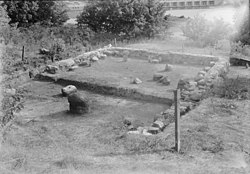
Lac qui Parle Mission Archeological Historic District | |
Minnesota State Register of Historic Places
| |
 Lac Qui Parle Mission Church (Ruins) | |
| Location | Lac qui Parle County / Chippewa County |
|---|---|
| Nearest city | Watson, Minnesota |
| Coordinates | 45°01′25″N 95°52′05″W / 45.023722°N 95.868194°W |
| NRHP reference No. | 73000971[1] |
| Added to NRHP | March 14, 1973 |
Lac qui Parle Mission is a pre-territorial mission in Chippewa County, Minnesota, United States, which was founded in June 1835 by Dr. Thomas Smith Williamson and Alexander Huggins after fur trader Joseph Renville invited missionaries to the area.[2][3] "Lac qui Parle" is the French translation of the native Dakota name, "Mde Lyedan," meaning "lake which speaks".[4][5] In the 19th century, the first dictionary of the Dakota language was written, and part of the Bible was translated into that language for the first time at a mission on the site of the park. It was a site for Christian missionary work to the Sioux for nearly 20 years.[2] Renville was related to and had many friends in the Native community, and after his death in 1846, the mission was taken over by the "irreligious" Martin McLeod. The relationship between the mission and the Dakota people worsened, and in 1854 the missionaries abandoned the site and relocated to the Upper Sioux Agency.[6][7]
The mission was reconstructed by the Works Progress Administration in 1942 and is now managed by the Chippewa County Historical Society in partnership with the Minnesota Historical Society.[3][8]
- ^ "National Register Information System". National Register of Historic Places. National Park Service. March 15, 2006.
- ^ a b Gates, Charles M. (June 1935). "The Lac qui Parle Indian Mission" (PDF). Minnesota History Magazine. 16 (2): 133–151. Retrieved February 9, 2012.
- ^ a b "Lac qui Parle Mission". Minnesota Historical Society. Retrieved February 9, 2012.
- ^ "Lac qui Parle Mission | Minnesota Historical Society". www.mnhs.org. Retrieved July 3, 2024.
- ^ Burnquist, Joseph A. A. (1924). Minnesota and Its People. Chicago: The S. J. Clarke Publishing Company. pp. 471–472.
- ^ Gilman, Rhoda R.; Carolyn Gilman; Deborah M. Stultz (1979). The Red River Trails: Oxcart Routes Between St. Paul and the Selkirk Settlement, 1820–1870. St. Paul: Minnesota Historical Society Press. pp. 47–49. ISBN 0-87351-133-6.
- ^ "Learn". Minnesota Historical Society. Retrieved July 12, 2022.
- ^ "City of Montevideo: Tourism". Retrieved February 9, 2012.